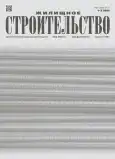The specifics of the formation of the natural and artificial landscape of the historical industrial enterprises of the Kama region
- Authors: Tkachenko S.G.1, Granstrem М.A.1, Lavrov L.P.1, Stieglitz M.S.2
-
Affiliations:
- Saint-Petersburg State University of Architecture and Civil Engineering
- St. Saint Petersburg Stieglitz State Academy of Art and Design
- Issue: No 1-2 (2025)
- Pages: 68-73
- Section: Articles
- URL: https://ter-arkhiv.ru/0044-4472/article/view/677192
- DOI: https://doi.org/10.31659/0044-4472-2025-1-2-68-73
- ID: 677192
Cite item
Abstract
This article is devoted to the peculiarities of the formation of the historical industrial territories of the Kama region in terms of their history, landscape, architecture and layout. The historical background of the founding of the Ural mining civilization and the features of the construction of Ural plants, including the choice of a site for the construction of the plant, technical features of factory dams and architectural and planning features of the layout of factory buildings, are considered. Pozhevsky and Ochersky factories are considered as examples of historical factory territories. Based on archival documents, books, articles and field surveys, an idea is formed about the factors that influenced the formation of the natural and artificial landscape of these territories, as well as about their current state.
Full Text
About the authors
S. G. Tkachenko
Saint-Petersburg State University of Architecture and Civil Engineering
Author for correspondence.
Email: archtkachenko@yandex.ru
Postgraduate Student
Russian Federation, 4, 2nd Krasnoarmeyskaya Street, Saint Petersburg 190005М. A. Granstrem
Saint-Petersburg State University of Architecture and Civil Engineering
Email: arch_project@bk.ru
Candidate of Architecture, Associate Professor
Russian Federation, 4, 2nd Krasnoarmeyskaya Street, Saint Petersburg 190005L. P. Lavrov
Saint-Petersburg State University of Architecture and Civil Engineering
Email: leonid.lavrov@gmail.com
Doctor of Architecture, Professor
Russian Federation, 4, 2nd Krasnoarmeyskaya Street, Saint Petersburg 190005M. S. Stieglitz
St. Saint Petersburg Stieglitz State Academy of Art and Design
Email: mstig@mail.ru
Doctor of Architecture, Professor
Russian Federation, 13, Solyanoy Lane, Saint Petersburg, 191028References
- Alekseeva E.V., Bystrova.T.Y. Industrial’noe nasledie: ponyatiya, tsennostnyi potentsial, organizatsionnye i pravovye [Industrial heritage: concepts, value potential, organizational and legal foundations]. Yekaterinburg: TATLIN. 2021. 164 p.
- Shipitsyna O.A., Solonina N.S. A comprehensive study of the industrial heritage of the Middle Urals. The Twelfth Tatishchevsky Readings. Proceedings of the All Russian Scientific and Practical Conference. Yekaterinburg, November 19–20, 2019. 145 p. (In Russian). EDN: XENVKL
- Solonina N.S., Shipitsyna O.A. Industrial’noe nasledie Urala: arkhitekturno-prezentatsionnaya aktualizatsiya [The industrial heritage of the Urals: architectural and presentation actualization]. Yekaterinburg. 2020. 380 p. EDN: EFHUYR
- Alekseeva E.V. Industrial heritage: species diversity, ways and methods of repurposing. Ural Historical Vestnik. 2021. No. 2 (71), pp. 46–54. (In Russian). EDN: OZERZE
- Alekseeva E.V. Historical symbols of urban identity: actualization of value. City, society, environment: history and vectors of development: Collection of materials of the II All-Russian Scientific and Practical Conference. Nizhny Tagil, October 28–29, 2022. Vol. 1. pp. 7–14. (In Russian). EDN: ZIAVNX
- Nikitin Yu.O. Tsepilova O. Synergistic analysis of the historical and cultural development of industrial architecture. Architecture and Engineering. 2021. Vol. 6. No. 1, pp. 32–39. EDN: EXMMVV. https://doi.org/10.23968/2500-0055-2021-6-1-32-39
- Pastukh O., Gray T., Golovina S. Restored layers: reconstruction of historical sites and restoration of architectural heritage: the experience of the United States and Russia (case study of St. Petersburg). Architecture and Engineering. 2020. Vol. 5. No. 2, pp. 17–24. EDN: SJMAYS. https://doi.org/10.23968/2500-0055-2020-5-2-17-24
- Popova D.D. Designing public spaces based on industrial heritage sites in Moscow. Architecture and Modern Information Technologies. 2022. No. 1 (58), pp. 91–107. https://doi.org/10.24412/1998-4839-20221-91-107
- Kanochkina N.A., Popova D.D. Organization of public spaces in the context of the development of industrial tourism. Systemnye technologii. 2020. No. 34, pp. 77–83. (In Russian). EDN: HYEIJT
- Stiglitz M.S. Neparadnyi Peterburg: nasledie promyshlennoi arkhitektury [Neparadny Petersburg: the legacy of industrial architecture]. Moscow: Progress-Tradition. 2020. 368 p.
Supplementary files

















